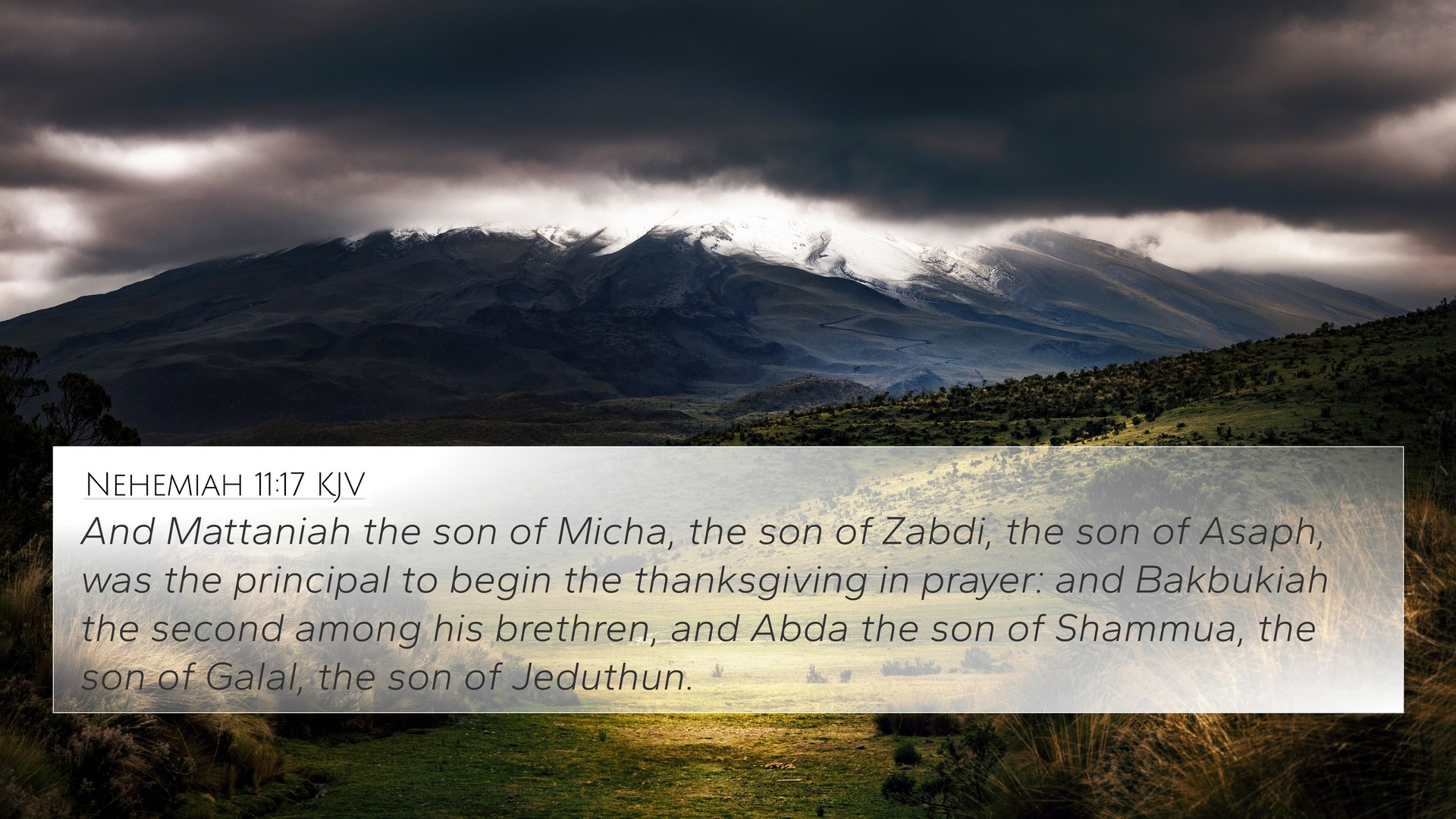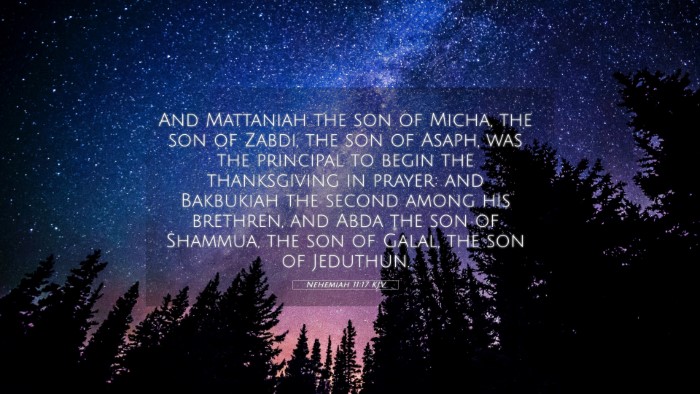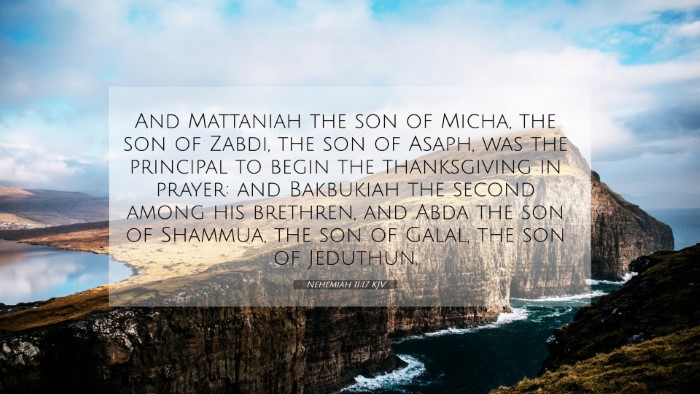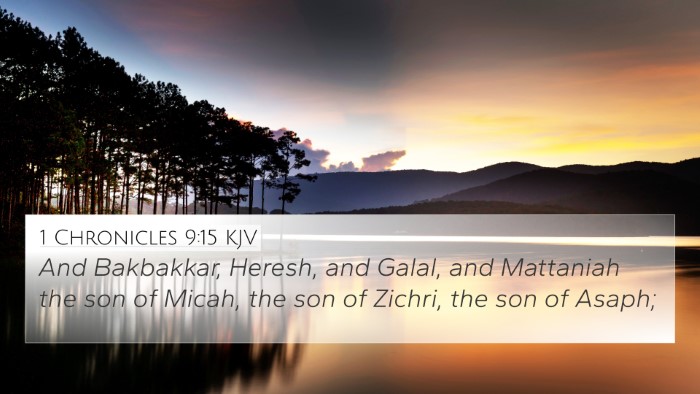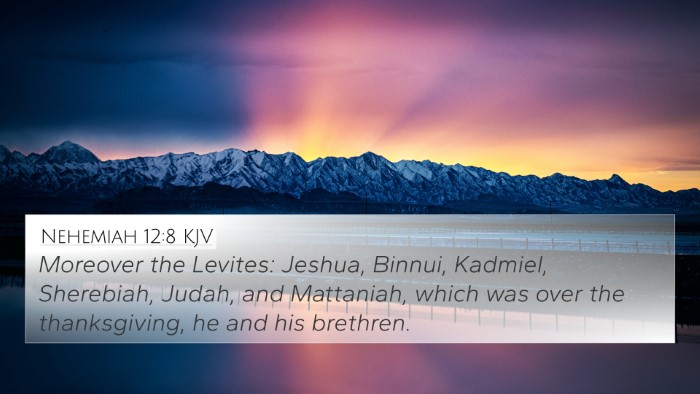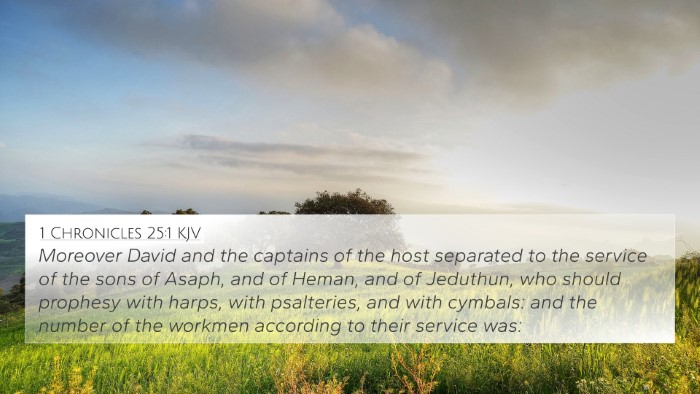Understanding Nehemiah 11:17
Nehemiah 11:17 reads:
"And Mattaniah the son of Micah, the son of Zabdi, the son of Asaph, was the principal to begin the thanksgiving in prayer; and Bakbukiah the second among his brethren: and Abda the son of Shammua, the son of Galal, the son of Juduthun."
Summary of the Verse
This verse highlights the roles of specific individuals in the leadership and spiritual practices of the Jewish community post-exile. Mattaniah's position as a principal figure for thanksgiving and prayer demonstrates the importance of worship in the rebuilding of Jerusalem's community.
Insights from Commentaries
Commentaries shed light on several aspects of Nehemiah 11:17, capturing the essence of the verse and its significance in the broader narrative.
Matthew Henry's Commentary
Matthew Henry emphasizes the spiritual leadership represented by Mattaniah, who was entrusted with the beginning of thanksgivings in prayer. This reflects the Jewish tradition of giving thanks as an integral part of worship. The mention of Asaph's lineage signifies the continuity of worship practices from the time of David, underscoring the importance of maintaining such traditions in the rebuilding of the nation.
Albert Barnes' Notes
Albert Barnes provides additional context by noting the role of Mattaniah as a Levite and the chief musician. This implies that worship was organized and intentional, adapting the old covenant practices in responding to new circumstances. He highlights the importance of leadership in spiritual matters and the community's dedication to the revival of proper worship.
Adam Clarke's Commentary
Adam Clarke adds that the duties of Mattaniah were crucial in the public worship of God, illustrating the need for designated leaders to conduct prayers of thanksgiving. Clarke also suggests that Bakbukiah, being a second leader mentioned, illustrates the importance of support and cooperation among members of the community in religious practice.
Thematic Connections
Nehemiah 11:17 is rich with themes of leadership, worship, and community restoration. Several overlaps in the Bible can be drawn from this verse.
- Worship and Thanksgiving: The act of giving thanks is a central theme throughout the Psalms, notably Psalms 100:4, which encourages entering His gates with thanksgiving.
- Spiritual Leadership: The importance of appointed leaders in worship appears in Exodus 28:1 where God called Aaron and his sons to serve as priests.
- Restoration of Community: In Ezra 3:10, the Levites build the altar of God and lead the people in worship after returning from exile, paralleling the efforts in Nehemiah.
- Musical Worship: The connection to Asaph links to Psalms 50 and 73, showcasing the significance of musical worship in praise and prayer.
- Community Engagement: Nehemiah 8:6 exemplifies collective worship when Ezra leads the people in reading the Law, highlighting group participation in thanksgiving.
- Prayer as a Foundation: 1 Thessalonians 5:16-18 encourages continual prayer and gratitude, echoing the sentiments expressed in Nehemiah’s leadership.
- Thanksgiving in Assembly: Romans 12:1 speaks to presenting ourselves as living sacrifices, linking community acts of worship with personal commitment.
Cross-Referencing Biblical Texts
This verse can be cross-referenced with the following biblical texts:
Conclusion
Nehemiah 11:17 is a rich source for understanding the foundations of worship, leadership, and community in the post-exilic period. The insights from various commentaries support a deeper exploration of how prayer and thanksgiving were not only practices but pivotal elements for the restoration of identity for the Jewish people. By connecting this verse with others across the scriptures, one can gain a fuller picture of the themes of gratitude and the necessity of leadership in spiritual matters.
Tools for Bible Cross-Referencing
For those wanting to delve deeper into the connections within the Bible, utilizing tools such as a bible concordance or a bible cross-reference guide can enhance your understanding. These resources enable effective cross-referencing Bible study, aiding in identifying themes and linking verses across both the Old and New Testaments.
